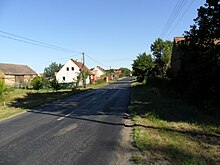Biecz (Brody)
| Biecz | ||
|---|---|---|

|
|
|
| Basic data | ||
| State : | Poland | |
| Voivodeship : | Lebus | |
| Powiat : | Żarski | |
| Gmina : | Brody | |
| Geographic location : | 51 ° 49 ′ N , 14 ° 50 ′ E | |
| Height : | 63 m npm | |
| Residents : | 231 (March 31, 2011) | |
| Postal code : | 68-343 | |
| Telephone code : | (+48) 68 | |
| License plate : | FZA | |
Biecz [ bjɛt͡ʂ ] ( German Beitzsch , 1937–45 Beitsch ; Lower Sorbian Bušc ) is a district with Schulzenamt ( Sołectwo ) of the rural community Brody (Pförten) in the powiat Żarski (Sorau district) in the Polish voivodeship of Lebus . Until October 5, 1954, Biecz was an independent rural community and then a Gromada , which was incorporated into Brody on January 1, 1973.
location
Biecz is located in the Polish part of Niederlausitz , 28 kilometers as the crow flies northwest of Żary and 14 kilometers east of the border with Germany . The surrounding towns are Grodziszcze in the north, Gareja and Ziębikowo in the east, Chełm Żarski and Tarnów in the southeast, Żytni Młyn in the south, Brody in the southwest, Datyń in the west and Koło in the northwest.
The village is located on Droga wojewódzka 286 and two kilometers north of Droga wojewódzka 289 . The settlement Rybitwy belongs to the place .
history
The place was first mentioned in 1316 when it passed into the possession of the aristocratic Wiedebach family. The place name is derived from the personal name Budisław . During the Thirty Years' War , Beitzsch was attacked by the troops of General Wallenstein in 1627 , and the castle originally in the village was destroyed. In 1721 the village church was built. Until 1806 the village belonged to the Electorate of Saxony and then to the Kingdom of Saxony .
Due to the resolutions passed at the Congress of Vienna , Saxony had to cede Niederlausitz to the Kingdom of Prussia in 1815. In the following year, a comprehensive regional reform was carried out in Prussia, since then the municipality of Beitzsch has belonged to the district of Guben in the province of Brandenburg . In the topographical-statistical overview of the administrative district of Frankfurt adO from 1844, 509 inhabitants in 63 houses are recorded for the town of Beitzsch. A manor, two farms and a water mill belonged to the village . In 1867 the municipality of Beitzsch had a total of 689 inhabitants, these were divided between the main town with 639 inhabitants and the village inn Hammerschänke with ten inhabitants and the paper mill settlement with 40 inhabitants. The village of Beitzsch had two farms, a water mill, a sheep farm and a brick factory. A wool spinning mill was operated in the paper mill district.
Since 1874, Beitzsch was the administrative seat of the administrative district of the same name , which, in addition to Beitzsch, also included the rural communities of Grötzsch and Seebigau. In 1881 the place was almost completely destroyed in a fire. In the census of December 1, 1910, the rural community of Beitsch had 420 and the manor district of Beitzsch 151 inhabitants. The community and the manor district were later united, and in 1928 the rural community of Grötzsch was incorporated into Beitzsch. In 1937 the spelling of the place name was changed in the course of the Germanization of Sorbian place names by the National Socialists in Beitsch .
After the end of the Second World War , the Lords of Wiedebach were expropriated. The district of Beitzsch was also dissolved. By establishing the Oder-Neisse border on August 2, 1945, Beitsch became Polish, the place name was changed to Biecz , the German residents were expelled and the place was relocated by Polish new settlers. In Poland, Biecz was initially an independent Gmina wiejska and initially belonged to the Poznan Voivodeship and from 1950 to the Zielona Góra Voivodeship . There Biecz belonged to the powiat Gubinski . On July 1, 1952, the municipalities Jałowice (with the district Lasek), Jasienica , Mierków , Osiek , Raszyn and Ziębikowo were incorporated into Biecz. In October 1954, an administrative reform was carried out in Poland in which most of the rural parishes were converted into gromadas . The rural community Biecz was divided into the Gromadas Biecz and Mierków, with the districts Grodziszcze, Jałowice, Jasienica and Lasek remained in the Gromada Biecz. Also in October 1954, Biecz was reclassified from the Powiat Gubinski to the Powiat Lubski .
On January 1, 1973, the Gromada Biecz was united with the Gromada Brody to form the new rural municipality Brody . In 1975 the Powiat Lubski was dissolved. Since 1999 Biecz has been part of the Powiat Żarski.
Web links
Individual evidence
- ^ CIS 2011: Ludność w miejscowościach statystycznych według ekonomicznych grup wieku (Polish), March 31, 2011, accessed on May 14, 2020.
- ↑ Arnost Muka: Serbski zemjepisny słowničk. Budyšin, 1927, p. 62 ( digitized version ).
- ↑ Topographical-statistical overview of the government district of Frankfurt ad O. Gustav Harnecker's bookstore, Frankfurt a. O. 1844 Online at Google Books , p. 78.
- ↑ Topographical-statistical manual of the government district of Frankfurt a. O. Verlag von Gustav Harnecker u. Co., 1867 Online at Google Books , p. 86.
- ↑ Municipal directory of the Guben district 1900. In: gemeindeververzeichnis.de , accessed on May 14, 2020.
- ^ Biecz / Beitzsch rural community. Historical index, accessed on May 14, 2020.



